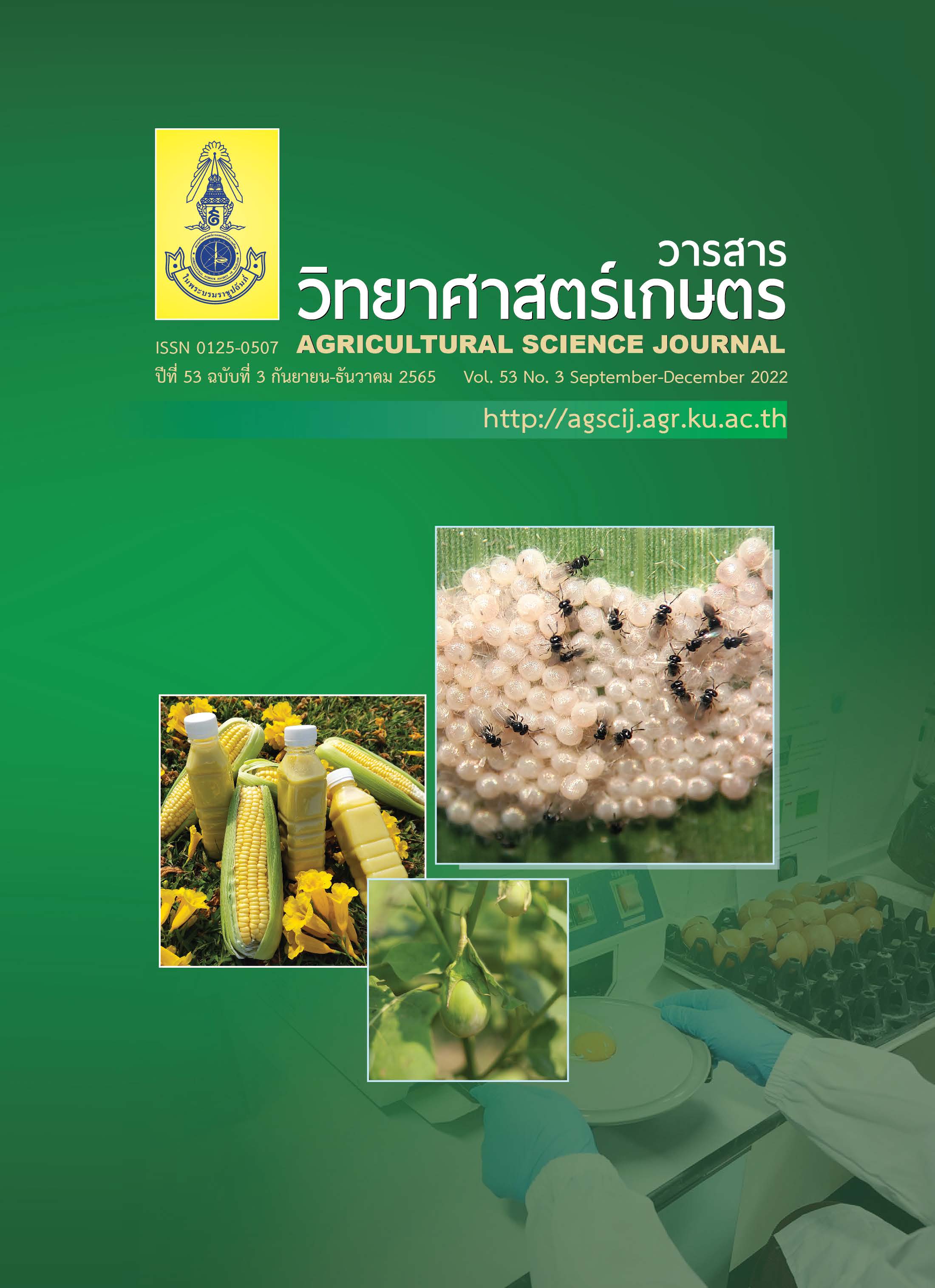อัตราฉีดพ่นน้ำหมักชีวภาพจากเศษเหลือทิ้งหน่อไม้ฝรั่งต่อการเจริญเติบโตและผลผลิตของมะเขือเปราะ (Solanum virginianum L.)
Main Article Content
บทคัดย่อ
การเก็บเกี่ยวผลผลิตและการตัดแต่งในขั้นตอนการผลิตหน่อไม้ฝรั่งก่อให้เกิดส่วนเหลือทิ้งค่อนข้างมาก ซึ่งเศษเหลือทิ้งดังกล่าวมีศักยภาพในการนำมาใช้เป็นธาตุอาหารพืชได้ การทดลองนี้จึงมีวัตถุประสงค์เพื่อศึกษาอัตราส่วนที่เหมาะสมของน้ำหมักชีวภาพจากเศษเหลือทิ้งหน่อไม้ฝรั่งต่อการเจริญเติบโตและการเพิ่มผลผลิตของมะเขือเปราะพันธุ์ไข่เต่า ณ แปลงผลิตเมล็ดพันธุ์ชุมชน สถานีวิจัยลำตะคอง อำเภอปากช่อง จังหวัดนครราชสีมา การทดลองแบบสุ่มสมบูรณ์ (Completely randomized design, CRD) ถูกออกแบบเป็น 5 ตำรับการทดลอง ทำ 4 ซ้ำ ซ้ำละ 3 ต้น ตำรับการทดลอง ประกอบด้วย ตำรับควบคุม (ไม่ฉีดพ่นน้ำหมักชีวภาพ) และตำรับการทดลองที่ฉีดพ่นน้ำหมักชีวภาพจากเศษเหลือทิ้งหน่อไม้ฝรั่งในอัตราส่วนโดยปริมาตรของน้ำหมักชีวภาพ:น้ำ เท่ากับ 1:2,000 1:1,000 1:500 และ 1:250 ผลการศึกษาพบว่า การฉีดพ่นน้ำหมักชีวภาพในอัตราส่วน 1:2,000 โดยปริมาตร ส่งผลให้มีจำนวนดอกต่อต้นมะเขือเปราะในช่วงอายุ 121 วันหลังปลูก สูงกว่าการฉีดพ่นในอัตราส่วนอื่นอย่างมีนัยสำคัญยิ่งทางสถิติ (P < 0.01) ทั้งนี้ ผลผลิตในแต่ละตำรับการทดลองไม่มีความแตกต่างกันทางสถิติ (P > 0.05) โดยมีแนวโน้มว่าการฉีดพ่นน้ำหมักชีวภาพในอัตราส่วน 1:2,000 โดยปริมาตร ส่งผลให้มีค่าเฉลี่ยน้ำหนักสดต่อผลและผลผลิตต่อไร่สูงที่สุด โดยมีปริมาณผลผลิตเพิ่มขึ้นร้อยละ 18.4 ของผลผลิตที่ได้จากตำรับควบคุม ดังนั้น การฉีดพ่นน้ำหมักชีวภาพในอัตราส่วน 1:2,000 โดยปริมาตร จึงเป็นอัตราส่วนที่เหมาะสมต่อการเจริญเติบโตและผลผลิตของมะเขือเปราะ อย่างไรก็ตาม การนำน้ำหมักชีวภาพจากเศษเหลือทิ้งหน่อไม้ฝรั่งฉีดพ่นให้กับพืช ควรใช้ควบคู่ไปกับปุ๋ยอินทรีย์หรือปุ๋ยเคมีเพื่อเป็นการเพิ่มธาตุอาหารพืชให้แก่ดิน
Article Details

อนุญาตภายใต้เงื่อนไข Creative Commons Attribution-NonCommercial-NoDerivatives 4.0 International License.
เอกสารอ้างอิง
Bray, R.H. and L.T. Kurtz. 1945. Determination of total organic and available forms of phosphorus in soil. Soil Sci. 59: 39–45.
Department of Agriculture. 2008. Organic Fertilizer Analysis Guide. Department of Agriculture, Ministry of Agriculture and Cooperative, Bangkok, Thailand. (in Thai)
Department of Agriculture. 2000. Symptoms of Nutrient Deficiencies in Plants. Soil Science Division, Department of Agriculture, Ministry of Agriculture and Cooperative, Bangkok, Thailand. (in Thai)
Department of Agriculture. 2011. Fruit and Vegetable Storage. Postharvest and Processing Research and Development Division, Department of Agriculture, Ministry of Agriculture and Cooperative, Bangkok, Thailand. (in Thai)
Land Development Department. 2006. Techniques and Methods of Using Biotechnology. Office of Experts, Soil Biotechnology Research and Development Institute, Bureau of Land Management Research and Development, Land Development Department, Ministry of Agriculture and Cooperative, Bangkok, Thailand. (in Thai)
Land Development Department. 2015. Land Development Guide for Volunteer Soil Healers and Farmers. Land Development Department, Ministry of Agriculture and Cooperative, Bangkok, Thailand. (in Thai)
Ministry of Agriculture and Cooperative. 2016. Notification of the Ministry of Agriculture and Cooperative Re: Prescribing the Method of Analysis of Chemical Fertilizer B.E. 2559, Method 1.05.02. Ministry of Agriculture and Cooperative, Bangkok, Thailand. (in Thai)
Mungkunkamchao, T., D. Jothiyangkoon, S. Pimratch and B. Toomsan. 2010. Fermented bio-extract and wood vinegar enhances growth and yield of tomato. Khon Kaen Agr. J. 38: 225–236. (in Thai)
Naphrom, D. and K. Sringarm. 2009. Training Manual Plant Hormone Quantitative Analysis Technique. Faculty of Agriculture, Chiang Mai University, Chiang Mai, Thailand. (in Thai)
Nopparatmaitree, M., A. Panthong, S. Paengkoum and P. Saenphoom. 2014. Effects of asparagus trims by-product supplementation in laying hens diets on nutrient digestibility and productive performance. Silpakorn U. Science & Tech. J. 8(1): 74–82.
Pansu, M. and J. Gautheyrou. 2003. Handbook of Soil Analysis: Mineralogical, Organic and Inorganic Methods. Springer, Berlin, Germany.
Pegiou, E., R. Mumm, P. Acharya, R.C.H. de Vos and R.D. Hall. 2020. Green and white asparagus (Asparagus officinalis): a source of developmental, chemical and urinary intrigue. Metabolites 10(1): 17.
Pratt, P.F. 1965. Potassium, pp. 1022–1030. In C.A. Black, ed. Methods of Soil Analysis. Part 2. Chemical and Microbiological Properties. Agronomy No. 9. American Society of Agronomy, Madison, Wisconsin, USA.
Punsak, W. and S. Pampasit. 2002. Fluid compost production from cassava starch waste, pp. 307–316. In Proc. the 40th Kasetsart University Annual Conference: Science, Natural Resources and Environmental Economics, 4–7 February 2002. (in Thai)
Ruengdechawiwat, S., P. Sanawong and S. Ngomprongbai. 2020. Effect of fermented fruits bioextracts on yield and growth of mungbean VAR. KPS 2. Agricultural Sci. J. 51(1)(Suppl.): 1–6. (in Thai)
Saeung, N. and S. Peungtrakool. 2012. The Utilization of Trimmed Asparagus Waste as Prebiotic in Laying Hen Diet to Increase Value of Waste from Economic Plant Process in Western Thailand. Senior Project, Silpakorn University Phetchaburi IT Campus, Phetchaburi. (in Thai)
Teanglum, A. 2013. Efficacy of fermented indigo leaf solutions on growth, yield and insect pest control in eggplant. JOA. 29(3): 249–256. (in Thai)
Walkley, A. and I.A. Black. 1934. An examination of Degtjareff method for determining soil organic matter, and a proposed modification of the chronic acid titration method. Soil Sci. 37(1): 29–38.
Wattana, K., R. Pankrun and A. Sriplai. 2022. The effects of various fermented bio-extract on yield of Thai striped eggplant (Solanum melongena L.) variety Nang Pha Ya. Agriculture and Technology Journal. 3(2): 76–85. (in Thai)


